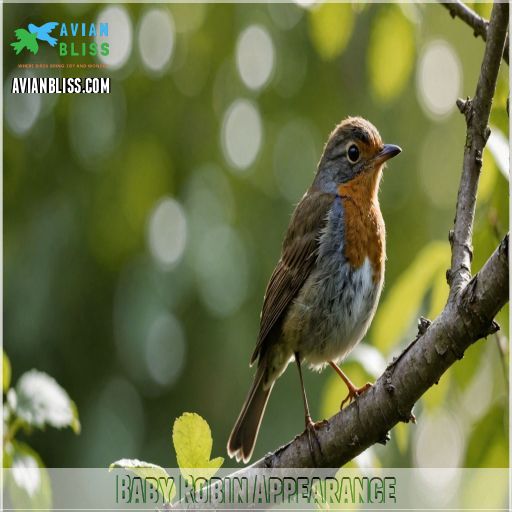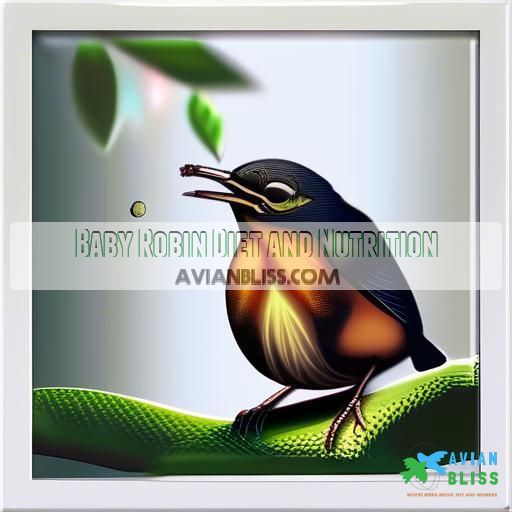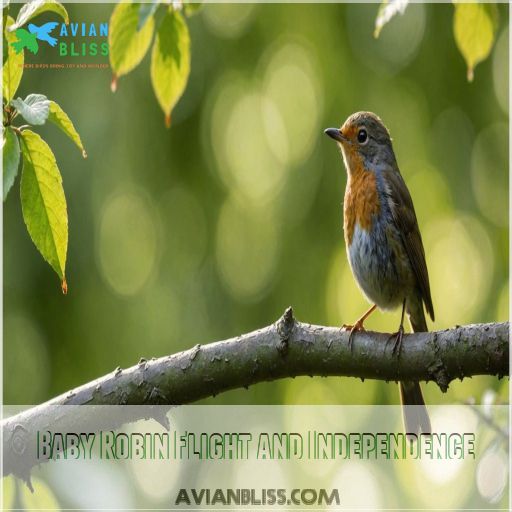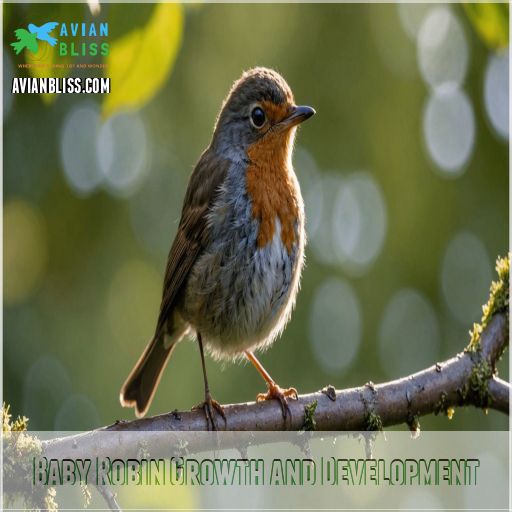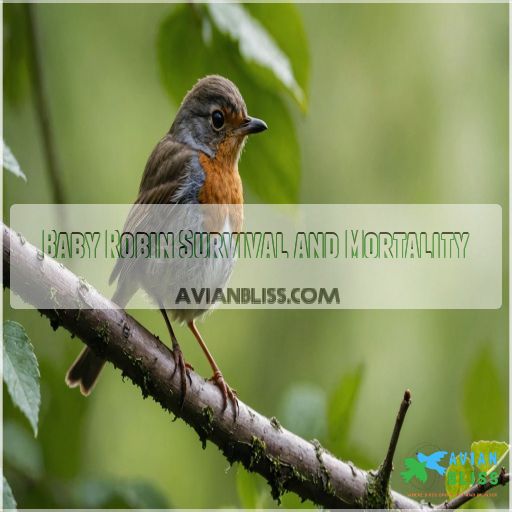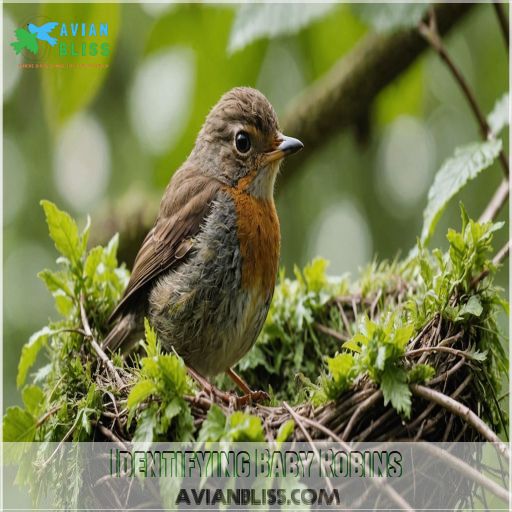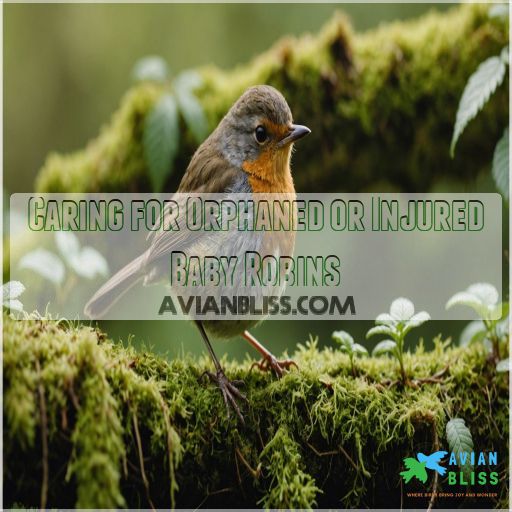This site is supported by our readers. We may earn a commission, at no cost to you, if you purchase through links.
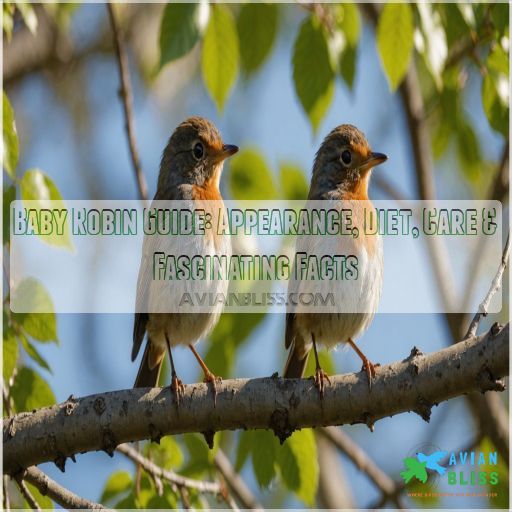
They depend fully on their dedicated parents for tasty meals of worms and bugs, perfect for strength and flight practice. During this time, their role models teach them how to forage and dodge predators.
As these tiny adventurers flap into independence, they might even be mistaken for speckled little rebels, showcasing their adorably miniature versions, and highlighting their journey to independence with plucky birds.
There’s much more to discover about these birds and their journey!
Table Of Contents
- Key Takeaways
- Baby Robin Appearance
- Baby Robin Diet and Nutrition
- Robin Nesting and Parental Care
- Baby Robin Flight and Independence
- Robin Egg Characteristics
- Baby Robin Growth and Development
- Baby Robin Survival and Mortality
- Identifying Baby Robins
- Caring for Orphaned or Injured Baby Robins
- Interesting Baby Robin Facts
- Frequently Asked Questions (FAQs)
- What is a baby American robin called?
- How do baby robins survive?
- What do baby robins symbolize?
- Are baby robins fledgling?
- Are baby robins cute?
- What should I do if I see a baby Robin?
- Can a baby robin survive on the ground?
- How do you identify a baby robin?
- What does a juvenile robin look like?
- How long does it take for baby robins to leave the nest?
- How do robins choose nesting locations?
- Do robins recognize human interference with nests?
- What do fledgling robins eat outside the nest?
- How do parent robins protect fledglings from predators?
- Can robins relocate if a nest is disturbed?
- Conclusion
Key Takeaways
- You’ll be amazed by baby robins’ rapid transformation from featherless hatchlings to fluffy, speckled fledglings – it’s like witnessing a tiny feathered comedy act!
- Robins are careful builders, crafting cozy nests to keep their young safe. However, these little adventurers are quick learners, mastering flight and independence with the help of their devoted parents.
- While baby robins face plenty of survival challenges, including predators and habitat loss, you can lend a hand by supporting conservation efforts and keeping an eye out for these feathered friends.
- Identifying baby robins is a hoot – just look for their distinctive speckled breasts, endearing begging calls, and clumsy but charming attempts at flight. They’re a true delight to observe in your backyard!
Baby Robin Appearance
Baby robins start out as featherless, blind hatchlings, but quickly transform into fluffy, speckled bundles of energy.
As they grow, their appearance evolves dramatically, developing the iconic red-orange breast and distinctive robin features that make them so recognizable, such as their distinctive robin features.
Birth and Early Development
When baby robins hatch, they’re as helpless as a fish out of water. During this stage, their eyes are closed, and they’re mostly concerned with nestling and staying cozy. Their parents tirelessly attend to every peep and squawk.
- Birth timing: Spring is prime time.
- Parental interactions: Constant care.
- Sensory growth: Rapid development.
Growth Stages and Physical Changes
How quickly do robins grow from blind, helpless chicks into independent juveniles?
Feather development kicks off with visible dark pterylae. Their beaks evolve as they master eating, while eyes open to a colorful world.
Watch their weight climb with increasing insect intake.
These changes, along with color transformations, fuel their dash to survival and autonomy .
Distinctive Features of Juvenile Robins
Spotting a juvenile robin’s distinctive features is like figuring out nature’s treasure map.
These young birds aren’t shy about showing off their spotted chests and backs, a feature that fades over time.
Look for these three juvenile traits:
- Spotted breast and back.
- Chunkier size than adults.
- Clumsy fledgling behavior and feeding habits.
Color and Plumage Development
Watching young robins, you’ll notice their dull plumage patterns gradually morph into the vibrant colors of adulthood.
Their feather growth includes a molting process, leading to a distinctive red breast. Imagine them changing like a chameleon, still munching on a bird diet of worms to fuel their transformation.
Soon, they’ll spread their wings, ready for their first bird flight.
| Plumage Stage | Appearance |
|---|---|
| Hatchling | Bare, minimal down |
| Day 4 | Pin feathers |
| Day 9 | Developing color |
| Juvenile | Speckled plumage |
| Adult | Red breast, smooth |
Size and Weight Changes
A baby robin’s growth is an exciting journey, from a tiny hatchling to a fledgling ready for flight.
Weight gain is essential, with daily weight influenced by feeding.
During the early weeks, robins quickly increase in size, reaching about one-eighth of an adult robin.
This rapid growth rate guarantees they’re strong enough for the challenges of survival and independence.
Baby Robin Diet and Nutrition
Get ready to explore the fascinating world of baby robin dining habits, where worm omelets and berry desserts are the daily specials.
You’ll discover how these tiny creatures start with a soft diet, lovingly served by their parents, before learning to forage like pros.
Initial Diet and Feeding Patterns
When those tiny, helpless hatchlings first emerge, they rely entirely on their parents to provide nourishment.
Camille, the devoted robin mom, diligently brought a steady stream of earthworms, insects, and even the occasional berry to feed her ravenous brood .
This constant cycle of feeding is essential for the nestlings’ rapid growth and development during their initial days, which is crucial for their survival on their initial days.
Food Sources and Types
Think about baby robins like tiny diners sampling nature’s buffet. In their early days, a mix of worms and insects forms their primary menu.
Mealworms, earthworms, and grubs make up the main dish, serving a protein punch just right for growth. Occasional fruit nibbles like blueberries add flavor.
Seeds? Not in their top picks, serving as a contrast to their preferred protein punch.
Role of Parents in Feeding
Parents play a key role in feeding baby robins, nurturing their change from nestling to fledgling.
They work tirelessly, with both regurgitating partly digested food initially, and then:
- Offering tiny worm pieces .
- Increasing feeding frequency as chicks grow.
- Selecting nutritious insects and berries (Source).
This funny, efficient teamwork makes for healthy, happy offspring!
Gradual Transition to Independent Foraging
A fledgling robin, like a teenager learning life skills, gradually shifts to independence.
Through parent-fledgling interaction, it starts recognizing food and hones foraging techniques.
Fascinated by shiny worms, the young robin explores territory establishment while employing survival strategies.
With each tiny adventure, it gains confidence, slowly weaning off parent support and savoring the freedom to fend for itself .
Importance of Water in Baby Robin Development
A baby robin’s hydration needs are very important for its growth and survival.
Water sources are as essential as food, helping to flush toxins and maintain hydration.
You might say water’s their unsung hero, keeping dehydration risks at bay.
Surprisingly, much of their water comes from juicy worms and fruits in their diet, a natural water delivery system.
Robin Nesting and Parental Care
You’ll be amazed at how robin parents carefully craft their nests and nurture their young with unwavering dedication.
From cozy nests to fledgling adventures, learn about the tender care and teamwork that prepare these chicks for life’s big flight.
Nest Construction and Maintenance
Robins are careful builders—imagine a tiny architect collecting mud, grass, and twigs for their nest.
Choosing hidden spots away from predators guarantees safety. While robins rarely reuse nests due to pests, maintaining cleanliness is their priority.
With each new brood, you witness nature’s cycle, as they instinctively prepare cozy, well-crafted homes for their young, ensuring a safe environment for their new brood.
Incubation Period and Egg Characteristics
Regarding robin eggs, you’ll find an array of vibrant "robin’s-egg blue" hues . This color stems from pigments in the mother’s blood, requiring no special nutrients in her diet. Robins typically lay 3-4 eggs per clutch, with incubation lasting 12-14 days from the last egg laid. The female alone incubates the eggs, dedicating around 50 minutes per hour to the task.
- Robins lay their eggs later in the day compared to most songbirds
- The male robin doesn’t have a brood patch and can’t incubate the eggs
- If the female is lost, the eggs won’t survive as the male can’t properly care for them
- Robins may produce up to 3 clutches per breeding season, though later clutches often have fewer eggs
Parental Roles in Raising Baby Robins
Among baby robins, teamwork makes the dream work and how. While mama takes the lead on feeding frequency and keeping eggs warm, papa’s on nest defense duty, ensuring no predator breaches their avian fortress.
American robins are also known to adapt their nesting locations, often placing them 5 to 25 feet above ground for added protection, a practice that reflects their territorial nature
.
Despite a modest brood size, parental care is unwavering, providing fledgling support with love and dedication, helping each chick spread its wings with safety and understanding.
Nestling Care and Development
Once those robin eggs hatch, the nest becomes a bustling hub of activity.
You’ll see the parents constantly on food delivery duty, catering to hungry mouths that seem to echo with sibling rivalry in every nestling vocalization.
Nestlings grow quickly, feathers replacing fluff, as they prepare for their debut flight into independence.
Fledgling Support and Protection
Supporting fledgling robins can feel like babysitting tiny acrobats. They’re vulnerable to predator threats and human interference.
Monitor their antics from a safe distance. If you’re tempted to intervene due to habitat loss or climate change, remember the best help is often doing nothing—nature resolves its own drama.
Keep pets indoors to prevent dramatic rescues!
Baby Robin Flight and Independence
In the exciting journey of baby robins, flight and independence are thrilling milestones every budding bird faces, as they venture from the nest to find their wings.
You’ll see them awkwardly mastering short flights and relying on their parents for guidance before setting off to establish their territories and seek a mate, embodying the true spirit of adventure.
Fledging and Early Flight Stages
You know that moment when kids leave home? Fledgling robins experience something similar—awkward first flights with parental guidance.
These little adventurers leave their cozy nests:
- Usually 13-14 days old
- Not yet master fliers
- Parents close by, offering support
- Exploring freedom with wobbly flutters
It’s nature’s grand, feathery leap of independence!
Development of Flight Skills and Strength
A young robin’s journey to master flight is like learning the ropes in a new playground.
Their wing muscle development starts with flapping wildly during first flight attempts.
Fledgling flight patterns are a bit wonky at first, but parental guidance helps smooth the ride.
As they build strength, these little aviators gradually move toward their sparkling independence.
Gradual Independence From Parents
As baby robins gain strength and confidence, they’ll gradually become more independent from their parents.
At around 10-15 days after fledging, they’ll start venturing out on their own to forage and explore.
Though still receiving occasional guidance from mom and dad, these young birds are well on their way to establishing their own territories and finding mates.
Post-Fledging Care and Support
Baby robins, after gaining their wings, need a bit of guidance to navigate the big, wild world.
Little by little, they master short flights, fueled by a nonstop buffet of bugs and berries from dad.
Staying vigilant about predators while learning to forage on their own, these young adventurers rely on parental support for survival.
Establishing Territory and Finding a Mate
Now that the fledgling has learned to fly, it’s time to stake a claim and find a companion.
These young robins perform:
- Mating rituals with spirited songs and dances.
- Territory defense, fending off rivals with fiery determination.
- Courtship displays, presenting gifts like tasty worms.
- Nest site selection, choosing cozy corners for future chirping chicks.
Each step is an exciting chapter of avian adventure! .
Robin Egg Characteristics
Explore the fascinating world of robin eggs, where color, size, and patterns tell nature’s story of birth and survival, often seen in birds that lay blue eggs
.
You might find their shiny blue shells so stunning that you’d want to match your kitchen decor to them!
Eggshell Color and Patterns
Among robins, the distinctive blue-green hue of their eggs adds a touch of mystery to your nature observations.
This color isn’t just for show; it’s a clever adaptation.
Eggshell pigments like biliverdin offer protection from sunlight while hinting at a robin’s nesting environment challenges and evolutionary triumphs
.
It’s nature’s brilliant artistry in action.
Egg Size and Weight
Egg size varies among robins, with each measuring about 2.8 centimeters (1.1 inches) and weighing around 6 grams, akin to a large grape in your hand.
Though small, this weight impacts clutch size, usually holding four eggs.
Shapes are slightly elliptical, designed for snug nest fits, while awaiting their moment in the sun.
Incubation Period and Hatching Process
As you’re imagining robin eggs’ sky-blue beauty, remember their delicate incubation. These gems stay snug at 104°F under mom’s warm belly.
This feathered nest is home sweet home for 12-14 days until hatching . During this time, mom provides the tender care essential for chick development, ensuring their hatching success and safety in carefully chosen woodpecker nesting locations
.
Number of Eggs in a Clutch
Most robins lay 3 or 4 eggs in a clutch, though they may occasionally have up to 5.
The vibrant blue color of robin eggs is due to pigments in the mother’s blood, similar to blue jay eggs, so her diet doesn’t need to include any special nutrients blue jay egg color
.
This clutch size helps boost the chance of brood success for these prolific nesters.
Frequency of Clutches Per Year
While robins lay about three to four eggs in a clutch, they might surprise you by raising two or three broods each season.
Timing their clutches depends on environmental factors like temperature and food availability.
Nest site selection is key; trust robins to choose wisely for brood success, ensuring their babies get the best start.
Baby Robin Growth and Development
As you watch baby robins grow, you’ll notice their rapid transformation from featherless hatchlings to lively fledglings, all while they master important skills.
It’s like witnessing a tiny feathered comedy act, as they practice their balancing and flying with plenty of wobbles and flutters, a true display of their rapid transformation.
Physical Growth and Development
Robin eggs are fascinating, but wait until you see the hatchlings grow. You’ll be amazed by their rapid physical development.
In the first few weeks, baby robins undergo significant changes as they move from the hatchling stage. During this time, they’re entirely dependent on their parents for survival, relying on them for warmth and constant feeding.
- Feather Development: From bare skin to fluffy down, those feathers sprout quickly.
- Eye Development: Eyes open from shut, revealing a world of wonder.
- Size & Weight Gain: They grow mightily, filling out fast.
Behavioral Development and Socialization
Imagine young robins figuring out their world, engaging in playful sibling rivalry and establishing a social hierarchy in the nest.
Their vocal communication is essential, strengthening the parent-offspring bond as they chirp for food and attention.
Nestling interactions teach them life skills, like handling nest space disputes—it’s their unique way of setting the stage for independence.
Sensory Development and Awareness
Baby robins are like little explorers, gradually developing sharp senses. Their sight improves rapidly, letting them locate food. Hearing sensitivity helps them detect parents’ calls and potential threats.
Touch response grows, aiding balance. While taste preferences influence diet, smell recognition is less pronounced.
These sensory developments build confidence, nudging them closer to understanding their environment and thriving in the wild.
Motor Skill Development and Practice
Young robins, while often clumsy, gradually master motor skills through thrilling adventures of nest hopping and wing flapping.
Despite some laughable, clumsy landings, these fledglings practice branch perching to gain balance. They move into coordinated flights, discovering freedom with each brave flutter.
Like athletes in training, they refine their movements, preparing for life’s challenges with every adventurous leap.
Cognitive Development and Learning
As baby robins grow, their cognitive abilities blossom. They quickly learn to recognize their parents and imprint on them, forming strong social bonds.
Their problem-solving skills emerge as they figure out how to access food sources and navigate their environment. Spatial memory helps them remember the location of their nest and favorite perching spots.
Through vocal mimicry, they learn songs from their parents, a key skill for communication and courtship.
Baby Robin Survival and Mortality
Exploring the survival and mortality of baby robins reveals a journey fraught with both danger and resilience.
From dodging predators to adapting to environmental challenges, these tiny creatures face a gauntlet of trials in their quest to grow into storied songbirds.
With your insight adding just the right touch of conservation wisdom.
Common Causes of Mortality
Just like a youngster facing life’s twists, baby robins face survival hurdles.
Common causes of mortality include:
- Predator threats: Raptors and snakes love a tasty nest snack.
- Disease outbreaks: Illnesses can spread quicker than gossip.
- Human impact: Habitat loss and climate change push robins to the brink.
With each challenge, these little adventurers push for freedom and survival.
Predation and Predator Avoidance
Making it in the world requires some clever tricks for baby robins, including staying dry in the rain with their water-resistant down feathers and hydrophobic skin. Parents also teach them adaptations like huddling for warmth.
With predator adaptations lurking, these fledglings rely on camouflage strategies, nest defense, and parental vigilance. It’s a survival game of hide-and-seek where escape tactics become critical.
Parents diligently distract predators, offering their young precious seconds to scoot to safety, keeping hopes aloft amidst nature’s constant challenge.
Environmental Factors and Disease
When robins face predators, they also contend with environmental factors. Climate change might shuffle their habitats, while parasites love nest chaos!
Follow these tips for baby robin well-being:
- Keep nests clean: Reduce disease risks.
- Limit pollution: Makes for safer homes.
- Watch for habitat loss: Protect natural spaces.
- Be alert for parasites: Check nests often.
Stay vigilant, nature’s on their side!
Human Impact on Baby Robin Survival
Pollution’s no friend to baby robins. Habitat loss and climate change shift their world, while pesticide use poisons their food and risks their health.
Ever notice how pet cats, prowling with the stealth of ninjas, pose a significant threat?
And those clear windows? They’re like invisible traps, causing deadly collisions. These human factors greatly impact their survival.
Conservation Efforts and Protective Measures
Robin conservation takes wing with efforts like safeguarding habitats and nest protection.
You can join citizen science projects to help monitor robin populations.
Be mindful of pesticide use, which affects baby robins. With climate change altering ecosystems, every small action counts in securing their future.
Let’s give these little feathered adventurers a fighting chance. (Source)
Identifying Baby Robins
Identifying baby robins is easy once you know what to look for.
From their distinctive speckled breasts to their endearing begging calls, these feathered youngsters have a charm all their own that sets them apart from other backyard birds.
These feathered youngsters have a charm all their own that sets them apart from other backyard birds by their endearing begging calls.
Visual Characteristics and Distinctive Features
Identifying baby robins can be a hoot!
Their plumage starts with fluffy down, eventually showing spots and streaks. Look closely for feather development and delightful eye color changes.
Their beaks are short and broad. Size-wise, think pocket-sized wonder compared to adult robins.
These tiny explorers are nothing short of enchanting, embodying growth and potential with every hop!
Behavioral Patterns and Vocalizations
From striking poses to their "feed me" soliloquies, baby robins could win an Oscar for their nestling communication!
With alarm signals as dramatic as a suspense thriller, they alert siblings like seasoned actors.
Their begging calls aren’t just noisy demands; they’re essential for survival. As they develop vocalizations, their antics add a touch of feathery chaos to the garden stage.
Sexing Baby Robins and Determining Age
You might wonder about baby robins’ age and sex.
Look for these clues:
- Color: Males usually have darker plumage with fewer pale shafts.
- Wing Patterns: Observe spot intensity.
- Behavior: Males can be more assertive.
- Vocalization: Males’ calls may differ.
- Growth Rate: Males often appear larger.
These hints might just crack the mystery!
Distinguishing Baby Robins From Other Birds
Wondering how to spot baby robins compared to other birds? These little ones have speckled brown feathers and distinctively large eyes. Their chubby bodies and short tails are tell-tale signs.
| Feature | Baby Robins | Other Birds |
|---|---|---|
| Plumage | Speckled brown | Various |
| Eye size | Large | Varies |
| Tail length | Short | Varies |
| Body shape | Round and chubby | Varies |
Spot these clues and you’ve cracked the code!
Caring for Orphaned or Injured Baby Robins
When you find a baby robin that seems lost or injured, it’s tempting to swoop in like their superhero.
But first, assess if they truly need help, as sometimes they’re just learning the ropes of robin life.
Assessing the Need for Intervention
Every so often, curiosity leads you to wonder if a baby robin needs intervention.
First, assess its stage: nestlings lack feathers, need nest checks, and parental care; fledglings seem clumsy but are often fine.
Look for signs of trouble: lameness, lack of bird behavior like hopping or chirping, or visible injuries on the chicks.
Providing Food and Water
Feeding a baby robin is a delicate task, but with the right approach, you can make sure it gets the nourishment it needs.
Offer a mix of canned cat/dog food, earthworms, and baby food beef – about three small mouthfuls every hour. (Source) Provide just a drop of water on the beak, never force it down.
Remember, patience and care are key when caring for this vulnerable fledgling.
- Use a small plastic syringe to feed
- Mix "Exact" formula with baby food beef
- Add a teaspoon of baby food applesauce
- Avoid overfeeding or forcing water
- Monitor the baby robin closely for signs of distress
Creating a Safe and Supportive Environment
Creating a cozy spot for baby robins can be as simple as providing shelter and making sure food sources are nearby.
| Nest Placement | Predator Protection | Shelter | Human Interaction |
|---|---|---|---|
| Hidden | Scare tactics | Natural cover | Minimize contact |
| High but accessible | Noisy deterrents | Bushes or trees | Observe quietly |
| Safe distance | Decoy animals | Nest boxes | Keep pets away |
| Away from hazards | Reflective objects | Dense foliage | No sudden movements |
Remember, balance their world with yours!
Seeking Professional Help and Rehabilitation
When you find a baby robin, calling a wildlife center is a wise first step.
They’ll have the expertise and permits necessary for ethical care and rehabilitation.
It’s like handing the reins to professionals who guarantee the critter’s safety.
Remember, these centers know the process and criteria for successful robin rescue and release.
Returning Baby Robins to the Wild
Returning a baby robin to the wild is like giving them the keys to their first car—exhilarating but nerve-wracking.
Key factors for success include:
- Ensuring nestling health and readiness.
- Timing reintroduction when parental presence is possible.
- Selecting a habitat suitable for their needs.
- Considering the ethical implications of human intervention.
Celebrate their newfound freedom and independence!
Interesting Baby Robin Facts
You’ll find baby robins fascinating as they hop awkwardly in gardens, showcasing quirky behaviors and adorable antics.
Discover how these young birds play a key role in ecosystems while serving as cherished symbols of renewal and joy in many cultures.
Unique Characteristics and Adaptations
Understanding baby robins‘ unique adaptations enhances how you care for them.
These fledglings excel at camouflage with their spotted chests. Their nestling behavior, including vocalizations, aids parental care, ensuring a steady prey selection like earthworms.
With parents working overtime, young robins gain the skills needed to thrive independently, becoming masters of their small world.
Baby Robin Behaviors and Quirks
Ever noticed how baby robins play the fame?
With vocal nestling communication and chaotic sibling rivalry, they put on quite a show.
Those tiny mouths are always open, engaging in begging behavior for food, while parental feeding becomes their life’s drama.
As fledglings, their exploration turns comical, ensuring life’s survival chaos never stops ().
Role of Baby Robins in Ecosystems
Baby robins play a key role in their ecosystems, acting as both predator and prey.
Their voracious appetites help control insect populations , while their droppings and discarded berries aid in seed dispersal.
As nestlings and fledglings, they provide food for predators, contributing to the overall biodiversity.
Robins are true ecosystem engineers!
Cultural Significance and Symbolism
Have you ever wondered why robins hold such a special place in folklore and mythology?
With their bright red breasts, robins are symbols of good luck, rebirth, and even messengers of joy in art and literature.
In Britain, they’re associated with Christmas, linked to Victorian postmen’s red uniforms, adding whimsical charm to the holiday, specifically making them messengers of joy in this context.
Fun and Interesting Baby Robin Trivia
With baby robins, you’ll find delightful tidbits! For starters:
- They’re camouflaged in hues allowing their green gall bladder to show!
- Their lifespan is brief but packed with growth!
- Babies energetically pop up for feeding at their parents’ arrival!
Robin parents tirelessly visit nests, modeling resilience and care.
Frequently Asked Questions (FAQs)
What is a baby American robin called?
A baby American robin, often called a nestling, starts life as a featherless bundle of potential.
The curious little creature, relying on its parents for food and warmth, enthusiastically learns to fly and explore the world.
How do baby robins survive?
A baby robin is hiding from predators and relying on parents for food and protection.
As they develop, their main strategy is to remain unseen, often mimicking statues to avoid detection by predators.
What do baby robins symbolize?
Robins symbolize new beginnings, joy, and the enduring spirit of loved ones who’ve passed on.
Their vibrant red breasts evoke passion and divine sacrifice, making them a cherished harbinger of happiness and hope.
Are baby robins fledgling?
Little adventurers leap from the nest, baby robins become fledglings around 13 days old.
Although they stumble at first, they’re building wings of freedom.
Parents still help them find food until they master flying.
Are baby robins cute?
You might find baby robins "so ugly they’re cute" as they grow from blind, nearly naked hatchlings to curious fledglings, capturing your heart despite their awkward appearance.
Their charm lies in their fragile beginnings and rapid growth, which can be quite endearing.
What should I do if I see a baby Robin?
Spotting a baby bird usually means letting nature take its course.
If it’s a nestling, return it to the nest nearby.
Fledglings hop around learning to fly—just watch from a distance.
Can a baby robin survive on the ground?
When robins leave the nest, it’s like a rite of passage—they’re learning to fly.
If they’re a fledgling with feathers and not in danger, let nature take its course.
Parents are usually nearby.
How do you identify a baby robin?
Baby robins sport speckled chests and backs, a fluffy appearance, and closed eyes at birth.
Their skin is semi-transparent, often showing internal features.
As they grow, down feathers appear, offering warmth and a fuzzy look.
What does a juvenile robin look like?
Juvenile robins charm with their speckled breasts and backs, standing out from adults.
Their feathers are adorned with spots, much like polka-dot clothing, bringing a playful twist to their appearance before they develop the classic red chest .
How long does it take for baby robins to leave the nest?
Fledgling robins take flight around 13 days after hatching, though the range is 9-16 days.
During this vulnerable time, they’ll hop around on the ground before mastering the skies over the next 10-15 days.
How do robins choose nesting locations?
Robins choose nesting sites that offer protection from the elements and predators, often on sturdy branches hidden by dense leaves.
They also seek locations near food and water sources, sometimes nesting on structures like eaves or ground.
Do robins recognize human interference with nests?
Like savvy detectives, robins recognize human interference around their nests, especially through repeated visits.
Increased human presence often boosts their defensive behavior, making them more likely to protect their young with startling zeal .
What do fledgling robins eat outside the nest?
When those little feathered adventurers leave the nest, they chow down on worms, insects, and berries.
They watch adults for tips and tricks, learning how to find tasty treats on their own and utilize adventurers.
How do parent robins protect fledglings from predators?
Parent robins protect fledglings by stealthy movements and frequent feeding, keeping them hidden from view.
They tirelessly monitor the environment for predators, using their calls to signal danger and guiding their young to safer foraging locations by using their calls.
Can robins relocate if a nest is disturbed?
Disturbed robins rarely relocate their nest.
Much like you wouldn’t immediately move house after a doorbell rings.
They prefer to stay near eggs or chicks, but frequent disturbances may cause them to abandon the nest entirely.
Conclusion
Imagine witnessing the astounding transformation of a baby robin from a "scruffy little alien" to a robust, plucky bird ready to soar into independence.
By understanding their appearance, diet, and care needs, you play a key role in their miraculous journey to adulthood.
Armed with fascinating facts and a sprinkle of humor, you’ll find yourself equipped to appreciate these tiny adventurers—and maybe even help one find its way home if it tumbles into your life.

